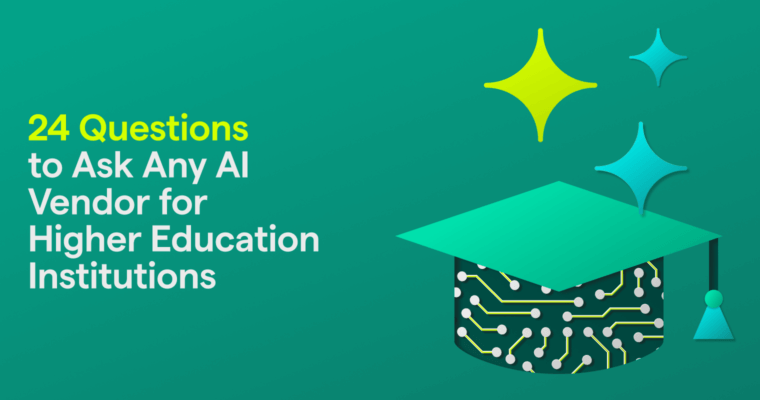
Among the handful of challenges that higher ed institutions face today is declining faith. Many Americans see college education as a “questionable investment,” and a demographic “enrollment cliff” is fast approaching.
While these findings are undoubtedly concerning, higher ed institutions have opportunities to prove their value. In particular, institutions need to show students how they will prepare them for an ever-changing professional environment and offer a clear path to career success.
So how exactly are institutions doing that? To find out, Grammarly for Education surveyed higher ed faculty and administrators across the country. Our findings exposed troubling gaps in higher ed’s career-readiness initiatives.
Higher ed professionals gave themselves top marks for career prep, our survey found. However, similar industry studies showed that employers and recent graduates felt higher ed did a poor job of preparing students for professional success. The most alarming gap in higher ed’s career-prep efforts was found in effective communication skills — the number-one competency employers seek in recent graduates.
Our survey delved into the nuances of higher ed professionals’ attitudes toward their institution’s career-prep programs, as well as where they saw opportunities to improve.
How realistic is higher ed’s self-assessment?
Both faculty and administrators rated their institutions’ career-prep offerings highly, but administrators had a particularly rosy view. Here’s what Grammarly found after surveying the administrators:
- 98% said their institutions’ career-prep initiatives did an effective job.
- 95% said their career-prep initiatives were effective regardless of students’ area of study.
- 91% said their career-prep initiatives were effective regardless of students’ backgrounds (e.g., learning abilities, native language).
Industry research highlighting employer and alumni perspectives paints a much darker picture, paving the way for viral headlines such as “Colleges Get F for Career Prep.” Here’s what industry studies have found:
- Only 11% of business leaders said they believed college graduates were well prepared for the workforce, according to a Gallup poll.
- Only 41% of recent graduates believed their college degree signaled they had the skills employers need, a Cengage Group survey showed.
How do we make sense of the disconnect between the career prep higher ed provides and what students and employers expect? Mary Rose Craycraft, Grammarly’s head of education customer success, highlighted two factors:
- Institutions lack a clear definition of career readiness: “Many schools are not aligned on what the actual end goal of their career-preparation programs is,” Craycraft said. “To gain that kind of alignment, institutions need to commit to defining career-readiness outcomes as a long-term goal.”
- On their own, traditional career-prep efforts won’t suffice: “The reality is that the more traditional methods of career support that many institutions rely on are no longer effectively meeting the needs of the modern student,” she added.
To close career-prep gaps, start with communication skills
Preparing students for life beyond the classroom is no small task. If there’s one area of skill development to prioritize, it’s communication.
Almost 96% of employers said strong communication was the most important competency they looked for in college graduates. However, only 47% found college graduates to be proficient at communication.
Even higher ed professionals recognize that their efforts to strengthen students’ communication skills have come up short. In our study, more than six out of ten respondents acknowledged that their students struggled with these issues:
- Using correct grammar.
- Avoiding text-speak or slang in written communications.
- Adopting a professional tone.
- Demonstrating confidence in their writing.
The traditional services that institutions offer to support communication skills — writing centers, career centers, and more — aren’t enough to meet students’ needs. As Craycraft explained, “Institutions make significant investments in their professors, their writing centers, tutoring programs, and a handful of other measures to improve students’ communication. But even taken together, these traditional methods of student support can’t close the gaps that exist today. Why not? A big part of it is that the writing center and tutors can’t be there to help all students all the time, whenever and wherever they write.”
So what steps can higher ed take to improve students’ communication skills?
- Embrace technology: Only 40% of the higher ed officials Grammarly surveyed reported that their institutions provided digital tools to help strengthen students’ writing. Higher ed is missing a significant opportunity to close the communication gap with digital tools that provide contextual writing suggestions to students in real time and help them learn as they work, which traditional methods of student support simply can’t do.
- Meet students where they are with personalized, always-on support: To have the greatest impact, institutions need to find ways to offer students writing support whenever and wherever they need it — whether that’s in the writing center at 4 p.m. or in their dorm room at midnight. Digital tools can provide students with around-the-clock support, helping them learn and improve while they’re writing. No professor, tutor, or writing center can offer that level of timely, individualized support.
- Help students build up their writing confidence to excel academically and professionally: Students who are more confident in their communication skills will be more likely to succeed in the classroom and beyond. Of the students using Grammarly, 96% said using the tool helped them become better writers, 97% said it helped them achieve their academic goals, and 94% said it increased their confidence when communicating with others.
The path forward for career prep
Our report reveals career-readiness gaps that higher ed administrators can’t afford to ignore, even (or especially) if they have confidence in their institutions’ career-prep initiatives. The report also shows the way forward. Institutions can make meaningful progress by providing personalized support to address the most important skill gap: communication.
This individualized support will not only prepare students for their careers but also improve institutions’ student engagement and ensure student success — both crucial in a time of declining enrollment.
To learn more about the state of higher education’s career-prep initiatives, download our full report or register for our upcoming webinar to explore what your institution can do to better support today’s students.






